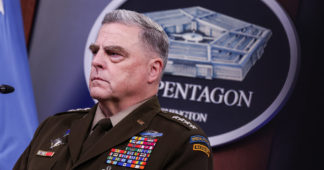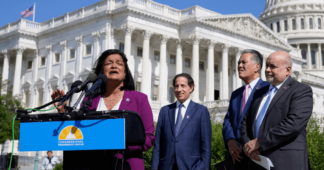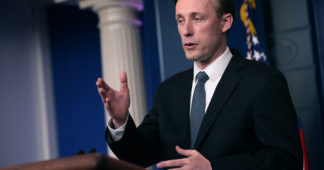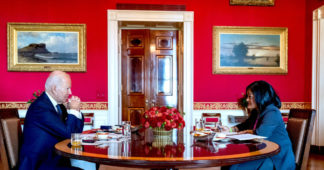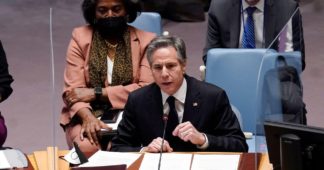Negotiating a diplomatic solution to the conflict is just common sense.
By Katrina vanden Heuvel
November 15, 2022
It might be time to give diplomacy a chance in the Ukraine war.
“When there’s an opportunity to negotiate, when peace can be achieved, seize the moment.” The author of that statement wasn’t a peace activist or a squishy liberal. It was Gen. Mark A. Milley, chairman of the Joint Chiefs of Staff, who has reportedly been pushing the Biden administration to press Ukraine to seek a diplomatic end to the war.
According to news reports, Milley’s view faces opposition in the White House. When Russian troops recently retreated from Kherson, national security adviser Jake Sullivan called it a “big moment” for Ukraine and reiterated that the administration would not push for a diplomatic end to the war. “If Ukraine chose to stop fighting and give up, it would be the end of Ukraine,” he said, bizarrely equating diplomacy with surrender.
But in fact, exercising diplomacy is just common sense—and there are signs that the White House might be slowly coming around to the possibility.
Russia has in effect already lost the war. President Vladimir Putin’s dreams of annexing Ukraine are shattered. His military weakness has been exposed, his economy damaged, his country isolated, his support weakened. His troops have suffered horrendous casualties; their morale is broken, their ammunition short.
Ukraine’s advances on the battlefield have likewise come at a horrible cost. Milley estimates that each side has suffered at least 100,000 casualties. Totally dependent on aid from the West, Ukraine’s forces are also short on soldiers, guns, air support, and artillery. Millions of Ukrainians have been displaced. Russia has savaged Ukraine’s electrical grid, causing widespread outages on Tuesday with its most virulent barrage of missiles to date (with some errant rockets reportedly landing in Poland and Moldova). Liberated Kherson, like much of the country, faces a “humanitarian catastrophe.” And as Putin mobilizes more troops, there is little chance that Russia can be dislodged from much of the Russian-speaking east, much less from Crimea.
Meanwhile, though the United States and NATO have rallied to Ukraine’s side, continued support is not unlimited. Sanctions imposed against Russia have contributed to what looks to be a cruel recession in Europe.
Angry demonstrations across the continent over the rising cost of living reveal growing popular opposition. Here at home, President Biden has enjoyed bipartisan support, but wannabe speaker of the House Kevin McCarthy (R-Calif.) provided the classic shot across the bow when he warned that there would be no “blank check” for Ukraine if Republicans take the House.
When members of the Congressional Progressive Caucus released a letter in late October urging diplomacy, the fierce blowback panicked members into withdrawing it overnight. In fact, however, Milley and the caucus had it right—as the administration’s stealth maneuvering reveals.
Despite public disavowals, the White House has tentatively been opening the door to negotiations. As journalist Aaron Maté has carefully detailed, the administration has orchestrated a number of leaks: that discussions with the Russians about the use of nuclear weapons had “lowered the temperature,” that the White House was encouraging Ukrainian leaders to “signal an openness” to negotiations, that Sullivan had engaged in confidential discussion with Putin’s aides about Ukraine, and that he had been “testing the waters” while in Kyiv on “how the conflict can end and whether it could have a diplomatic solution.”
The administration is tiptoeing on a tightrope, as it doesn’t want to undermine Ukrainian resistance, allied unity or domestic support. Yet the West’s interests clearly differ from the Ukrainians’. On the battlefield, NATO unity was forged around limits: not putting troops on the ground and exercising caution as to which arms go to Ukraine. Interests similarly diverge on negotiations. Given the horrendous damage done to his country, Zelensky will find compromise with the Russians repugnant, and ceding territory—even returning to the status quo ante—difficult to swallow. His best chance would be to drag the United States and NATO into the war as active combatants, but neither wants to go there.
With an estimated price tag of $1 trillion to rebuild Ukraine, the imperative to bring the war to an end is apparent, and more voices are cautiously pushing for a diplomatic resolution. In a recent column, former UN ambassador Tom Pickering and George Beebe, director of grand strategy at the Quincy Institute for Responsible Statecraft (he also served as a special adviser on Russia to former Vice President Dick Cheney), acknowledge the seemingly insurmountable obstacles while arguing that diplomacy is the only way to end the war. To those who claim that the time is not right, they reply that diplomacy takes time and preparation should start now. To those who argue that the border questions are insoluble, they suggest that diplomacy could begin with less knotty issues: ways to reduce civilian casualties, build mutual confidence and lay the groundwork for an eventual cease-fire.
The Russian invasion outraged opinion worldwide, even if much of the world chose not to take sides in the battle. In the United States, it stoked patriotic fever and made truth an early casualty. As the progressive caucus debacle showed, the bellicose will seek to squelch the calls for peace or negotiation. But the stakes are too high for us to sit idly by as the catastrophe spreads and the costs—and the risks—keep growing.
We remind our readers that publication of articles on our site does not mean that we agree with what is written. Our policy is to publish anything which we consider of interest, so as to assist our readers in forming their opinions. Sometimes we even publish articles with which we totally disagree, since we believe it is important for our readers to be informed on as wide a spectrum of views as possible.
